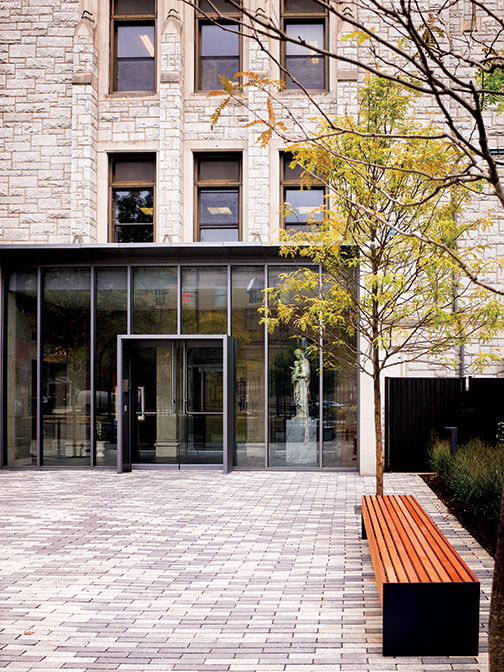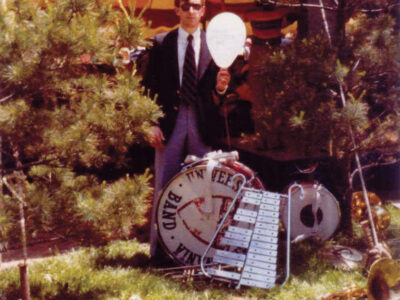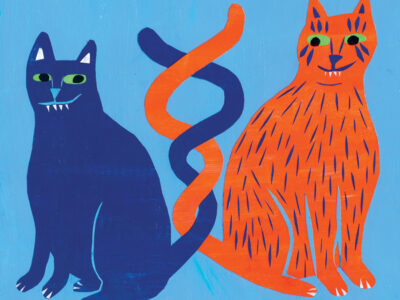
Over multiple locations and cultural changes, the country’s oldest Newman Club has helped shape the spiritual and social lives of Penn’s Catholic community.
“The world may be dark. Penn may be stressful. But God continues to delight in us,” says Gabrielle Ramos Nu’20, the current president of the Penn Catholic Newman Community’s student executive board.
For Ramos, the Newman Center is a refuge where she can draw strength from her faith and inspiration from her fellow students and the center staff, which includes a priest appointed by the Philadelphia Archdiocese and a team of campus lay ministers. Together, they are “building the kingdom of God, here in University City,” she says.
Ramos is the latest in a line of Penn students who’ve found a home at the Newman Center stretching back to Timothy Harrington, a graduate medical student who founded the very first club to bear the name here on campus in 1893. (To mark its 125-year anniversary, the Newman community held a celebration in October, which featured panel discussions and speakers, masses and prayers, as well as a beer garden, dinners, and a gala.)
A homesick Wisconsin farm boy working his way through Penn as a teacher, Harrington modeled the club on one he’d been involved with as an undergraduate at the University of Wisconsin. The name originated with his group, however, and honors Cardinal John Henry Newman (1801–1890), who was recently sainted by Pope Francis. Newman was a theologian whose works include The Idea of a University, which champions rigorous education in the sciences and humanities alongside the study and practice of faith.
Following an eight-year lull in the early 1900s, the club was revived under the leadership of Father John Keogh. He oversaw Newman Hall in a pair of mansard-roofed homes in the 3700 block of Spruce Street, with offices, a chapel, and living space for 25 people. Over the next quarter century, the energetic Keogh—who also found time to run a Catholic temperance organization—built a national network of Newman clubs based on Penn’s model at hundreds of state and private secular universities.
Over his tenure in the 1920s and 1930s, women began to take leadership roles as Newman officers, and members with Italian, Spanish, and other ethnic surnames joined the older Irish ones. Newman-sponsored plays rated coverage in Philadelphia newspapers and the group published its own scholarly periodicals. During the Great Depression, Newman volunteers served at city settlement houses and hosted discussions on topics like labor, relief, and abortion, along with the more traditional menu of retreats, outings, and devotional services.
After Newman Hall was demolished, displaced by the University’s 1960s-era expansion, the archdiocese built the two-story Newman Center on Chestnut Street familiar to most alumni. Dedicated in 1970, this structure featured a big kitchen and a simple chapel in the spirit of Vatican II, but no residential space, theater, or classrooms.
In a historical piece on the Newman website, student board member John Ortega C’20 quotes the 1972 Record yearbook to evoke the atmosphere of the center as a place that “offers you friendship, God-talk, good food, good noise, quiet if you want it, conversation … the Spirit, ping-pong, prayer, a chance to help … comfy chairs, someone to talk to if you need it, books of all sizes, Mass on Sunday, a nice place to study, and maybe a little shine when things look dark.”
In the 1980s, inspired by Catholic social teaching, students including Lucy Randel C’84 ChE’84 and Stephanie A. J. Dangel C’84 G’84 W’84 led groups of volunteers to Holmesburg Prison and the Youth Study Center juvenile detention facility, as well as nursing homes and soup kitchens. Vince Santilli C’84 recalls a spaghetti-and-mussels dinner at the Triangle Tavern, at which Father Tom Hagan, a popular guest preacher, introduced Santilli, who headed the conservative Penn for Rizzo mayoral effort, to Joseph Killackey W’85 WG’03, cohead of the liberal Penn for Goode group, and in a long debate got them to agree on the city’s problems, if not all the solutions.
More personal connections were made, as well. Among the couples brought together by their involvement in the center were Michael B. Bryan C’85 and Cathy Petruccelli Bryan Nu’84 GNu’88, who met at a January 1984 Penn Newman retreat in Fairmount Park. At first, Michael recalls, “I thought she was sad, and she thought I was a [jerk].” The last exercise of the retreat was to talk to “someone you hadn’t connected with.” The pair sat at a distance, chatted with increased interest, and made a date. A week later they shared a kiss at Penn’s Landing, where, he says, “I told her our children would know that place.”
Financial constraints, declining attendance at the center, and the renovation of St. Agatha-St. James church in the 2000s prompted church authorities to consolidate Newman programs at Penn and Drexel University, which up until then had been separate. In 2018, the archdiocese sold the center’s land for $18.7 million to a developer for a high-rise apartment complex, now under construction. The center’s latest home—inaugurated at the 125th anniversary celebration—is in a renovated space in the former parish school and the lower level of the adjacent St. Agatha-St. James church building.
Mass attendance has rebounded by 20 percent in recent years, according to parish records. And under Ramos and her classmates—backed by current pastor Father Carlos Keen, who took over as parochial administrator for St. Agatha-St. James and Newman Center chaplain in 2014, Newman Ministries director Brother Patrick Travers, and a corps of young staffers from the Fellowship of Catholic Students (Focus)—the Newman Center currently runs a broad slate of programs including Bible studies, dinners with speakers (such as a papal security officer, musicians, and a priest who trained as an exorcist), and community service projects.
Ortega recalls that he “could not find another Filipino who was active” at Newman in his freshman year. Then he met Eugene Enclona EAS’21 at a Newman retreat, and they helped organize a Filipino student Mass that now attracts 70 people per month. Ortega says he’s pleased by efforts such as increased participation with the Christ in the City ministry, in which volunteers go out in the streets to engage homeless people in conversation; a high school tutoring group; and nascent work with Broad Street Ministries, a Presbyterian service group. The mix of community, prayer, and work “cannot be replicated anywhere else on Penn’s campus,” he says.
A few Newman students have resumed the old Newman Hall practice of living in community. The homes mix Drexel and Penn Catholics, says third-year Drexel student Vince Dragone, who is also leader of a Catholic men’s student group that draws from both schools.
Father Keen is fond of Cardinal Newman’s Latin motto cor ad cor loquitur—heart speaks to heart. Newman members make time for one another to listen. That’s the basis for “reconciliation with each other, with our environment, with God,” he says.
“So often we tell everyone that things are all right, but we are feeling so much pressure,” he adds. “It’s OK, here, not to be OK, and to ask for help, for support. What we are trying to do here is make a family.”
—Joseph N. DiStefano C’85





Love this!